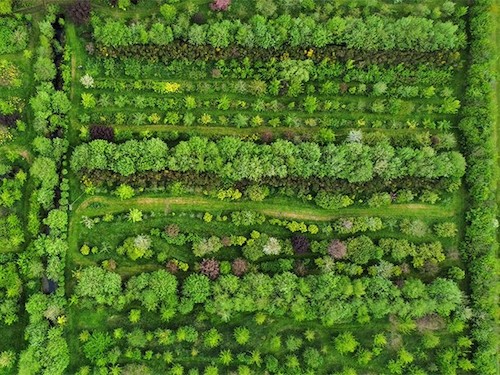Climate change is making traditional farming more difficult. Alternative methods that can better withstand extreme weather conditions are needed.
So-called food forests offer potential here, but have so far been only a marginal phenomenon. Over the past six months, the Institute of Geography at the University of Osnabrück, in cooperation with the Huize Aarde Foundation from Enschede, the Rhine-Waal University of Applied Sciences from Kleve, and the Voedselbosbouw Nederland Foundation from Lelystad, have been studying the potential for food forests in the German-Dutch border region. The research project “Regenerative Agriculture” was co-financed by the European Regional Development Fund (ERDF) as part of the Interreg VIA program between Germany and the Netherlands.
Food forests are multifunctional systems that combine agriculture, horticulture and forestry in the same area. This type of food production avoids the use of manure, synthetic fertilizers and pesticides. Professor Dr. explains Martin Franz from the Institute of Geography at the University of Osnabrück. So tall chestnut or walnut trees are combined with low apple, cherry and pear trees. Then hazelnut bushes and various types of berries are planted underneath.
“After a growth period of 10 to 15 years, these forests can produce up to 10,000 kilograms of food and other products per hectare every year,” Nicolas Geiger of the Voedselbosbouw Nederland Foundation reported on experiences from the Netherlands. Many food forests have already been planted in the Netherlands over the past 20 years. “We can now learn from the experiences there to professionalize this approach,” Geiger adds. The project team is now planning a follow-up project with more partners from the region.
Allowing nature to take its course in food forests can improve soil fertility, improve pollination and prevent disease outbreaks in plants. “In addition to income from wood, fruits or nuts, farms also benefit from an improved microclimate, a healthier environment, increased carbon sequestration and improved water quality and storage in the food forest. The food forest also serves as an ecologically valuable habitat for various animal and plant species. Tobias Wönscher from the Faculty of Life Sciences Rhine-Waal University of Applied Sciences.
In order to displace the food forest approach, concepts need to be developed to promote and professionalize food forests. The aim is to develop food forests in some German and Dutch pilot areas, where we will then work with farmers to professionalize the food forest approach. “For example, we are testing how to use robots to simplify the harvesting process, which was previously very complex,” explains Alphonse Ojtiwal from the Huize Aarde Foundation. As part of the project, twelve agricultural companies were identified that would like to contribute their land. Companies interested in marketing food forest products were also found.
Source: University of Osnabrück
The article was published online by: /Doris Holler/

“Total coffee aficionado. Travel buff. Music ninja. Bacon nerd. Beeraholic.”







More Stories
Wolfsburg instead of Wörthersee: The first GTI meeting starts at Volkswagen headquarters
Pecco Bagnaia (Ducati): Testing on the new Panigale/MotoGP
From autumn onwards, U2 will be playing again at Karlsplatz.